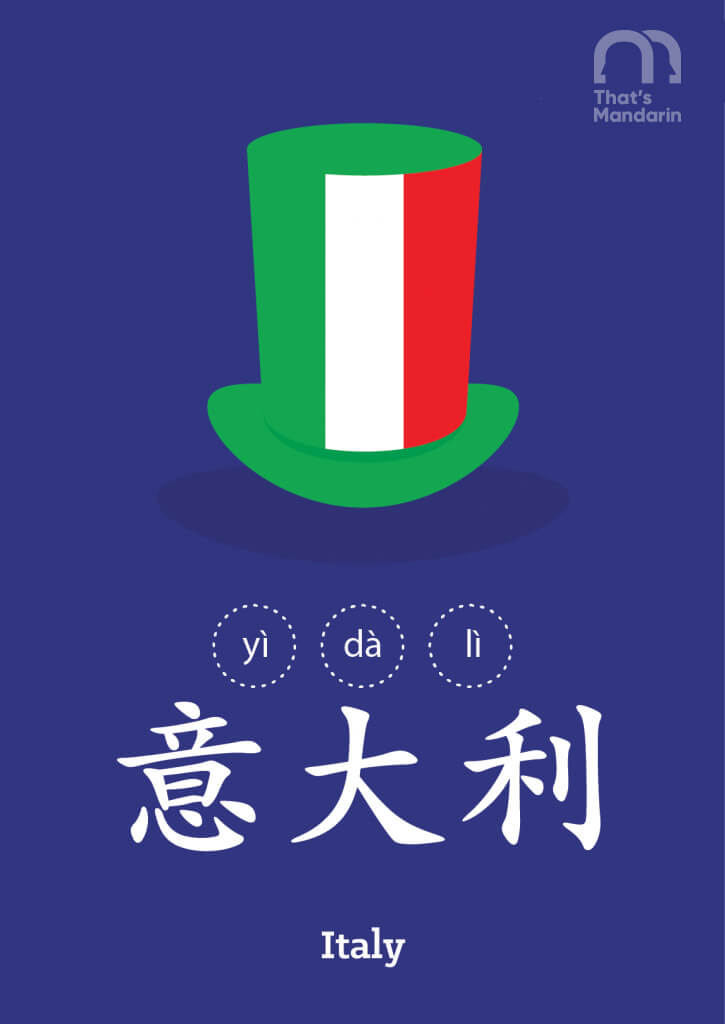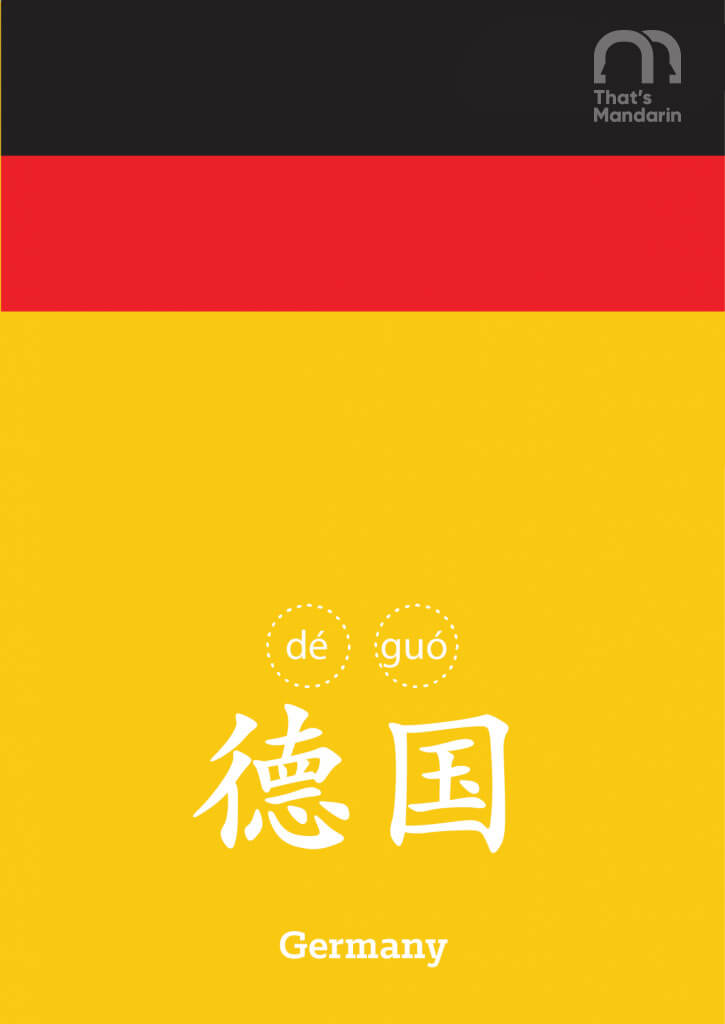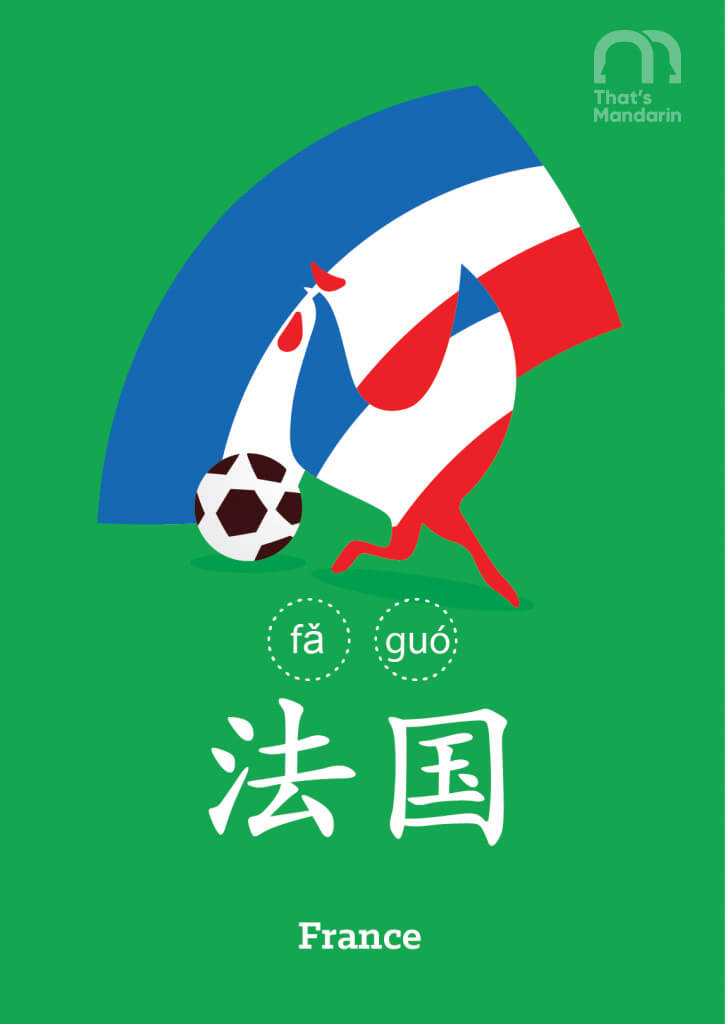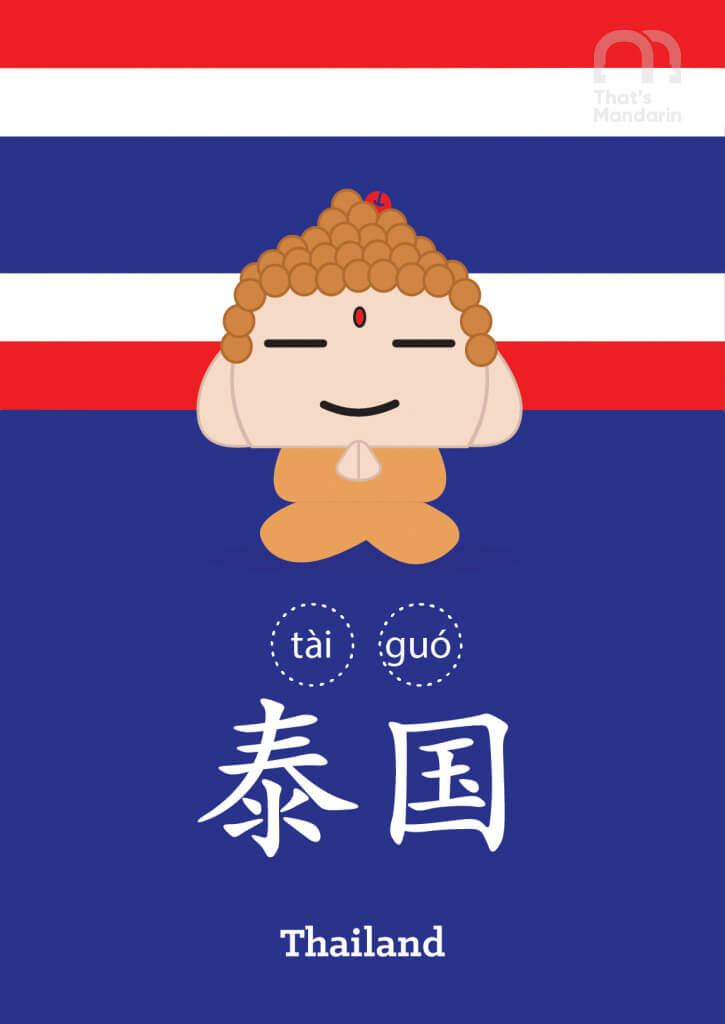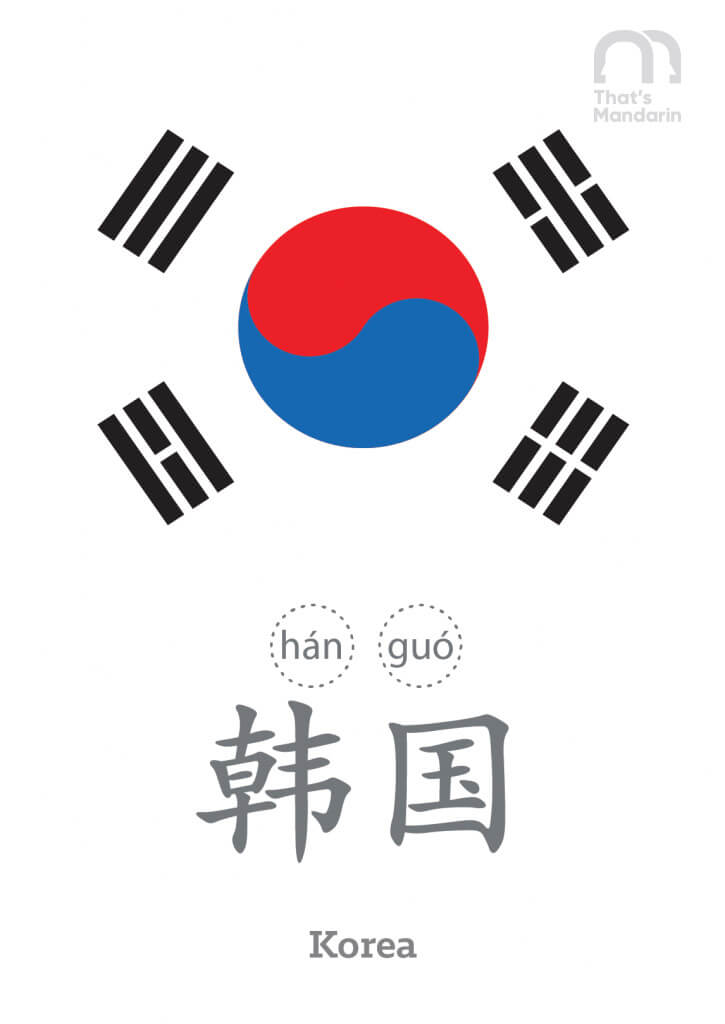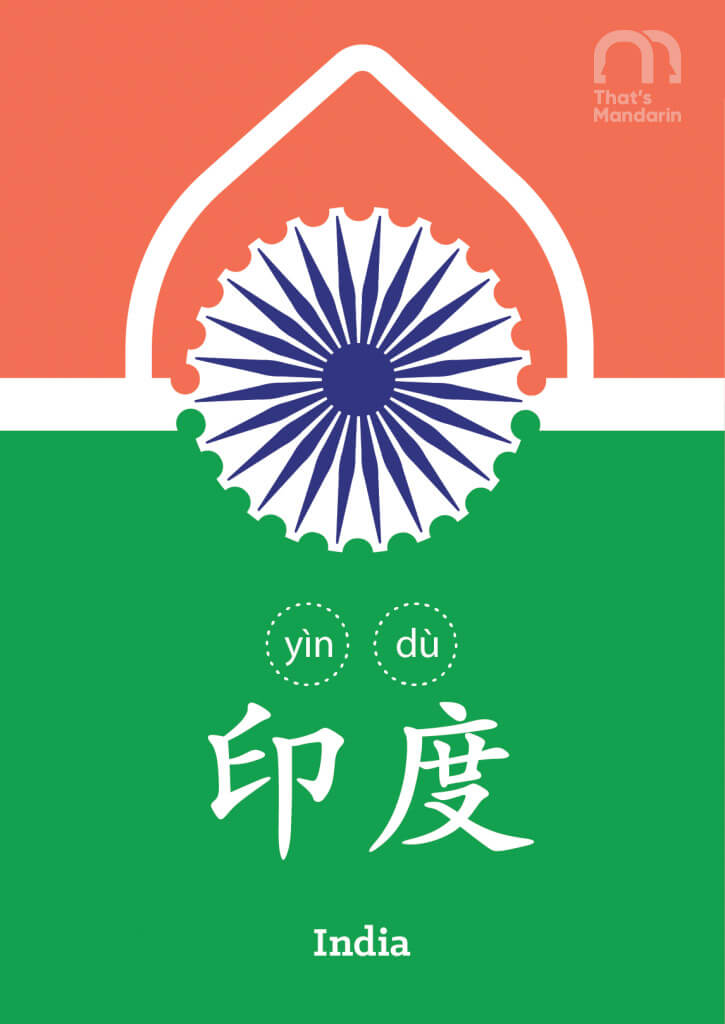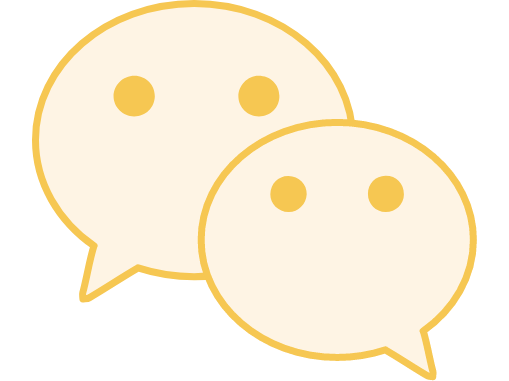Country Names in Chinese – Learn How to Say Countries in Mandarin
Italy | 意大利 (Yìdàlì)
Italy is called 意大利 (Yìdàlì) in Chinese. It sounds exactly like its English pronunciation. Speaking about Italy and China, the first person that comes into your mind must be Marco Polo!! He’s famous for his great adventure in the east, but what did he actually do in China. Let’s find out today.
At the age of seventeen, Marco set off on a voyage to Asia with his father and his uncle. The distance they traveled was almost 15,000 miles (24,000 km)!! You can check out the route he took on the map. He later documented this voyage in his book “The Travels of Marco Polo” (马可波罗游记, Mǎkě Bōluó Yóujì).
The book starts with a preface describing the travels of Marco’s father and uncle. In 1266, Marco’s father and his uncle reached Beijing. There they met Kublai Khan, a Mongol ruler and founder of the Yuan Dynasty. Mongolians were ruling China at the time. Kublai received the brothers with hospitality. Kublai requested the brothers bring back some souvenirs from Europe.
In 1271, Marco, his father and uncle set off on their voyage to fulfill Kublai’s request. Three and a half years after leaving Venice, when Marco was about 21 years old, they finally reached the Kublai’s summer palace.
Marco knew four languages, and the Polo family had a great deal of knowledge and experience that was useful to Kublai. It is possible that he became a government official. He wrote about many imperial visits to China’s southern and eastern provinces, the far south and Burma.
After a 24-year voyage, he was able to go back to Venice eventually. In his book, he praised China highly, which made Europeans all look forward to visit China. But some other people argue that there are many inventions and exaggerations in his book. Anyway, the book was one of the most detailed materials provided for westerns to learn about the eastern world.
Italy | 意大利 (Yìdàlì) – Learn the Chinese Name for Italy
Italy is called 意大利 (Yìdàlì) in Chinese. It sounds exactly like its English pronunciation. Speaking about Italy and China, the first person that comes into your mind must be Marco Polo, who traveled to China during the Yuan Dynasty. But what did he actually do in China? Let’s find out today.
At the age of seventeen Marco set off on a voyage to Asia with his father and his uncle. The distance they traveled was almost 15,000 miles (24,000 km). He later documented this voyage in his book “The Travels of Marco Polo” (马可波罗游记, Mǎkě Bōluó Yóujì), a book that introduced China to Europe.
The book starts with a preface describing the travels of Marco’s father and uncle. In 1266 they reached Beijing, where they met Kublai Khan a Mongol ruler and founder of the Yuan Dynasty. Mongolian, who were ruled China at the time Kublai, received the brothers with hospitality. Kublai requested the brothers bring back some souvenirs from European goods.
In 1271 Marco Polo, his father and uncle embarked set off on their voyage to fulfill Kublai’s request. Three and a half years after leaving Venice when Marco was about 21 years old, they finally reached the Kublai Khan’s summer palace.
After spending 24 years in China he was able to go back to Venice eventually. His book highly praised China’s culture economy and innovations, making Europeans eager to visit China.
Germany | 德国 (Déguó)
德国 (Déguó) doesn’t come from the name “Germany”, but from “Deutschland”. We selected the first syllable “De” and found a character “德 (dé) which has a similar pronunciation; then we placed 国 (guó) behind it.
Again, Chinese people chose the word with the best meaning for Deutsch. 德 (dé) means “moral” – from 道德 (dàodé) – in Chinese. So you can regard 德国 (Déguó) as a country of morals.
Let’s meet a Geologist who is presumably the person that travelled to most places in China.
Richthofen was born in Carlsruhe, Prussian Silesia, and was educated in Breslau and Berlin. He traveled or studied in the Alps of Tyrol and the Carpathians in Transylvania.
In 1868, Richthofen received the support of the Bank of California and carefully designed seven routes of his geological survey and then came to China. In November 1868, he started travelling around China. During 7 trips, he travelled 18 provinces in China, far more than any Chinese at that time. (Maybe you are the one who can break his record.)
During the trips, he inspected the coal mines in 山西 (Shānxī) and 陕西 (Shǎnxī) carefully. He wrote a letter that China is the country with most coal and the coal in 山西 (Shānxī) could supply coal to the whole world for thousands of years.
When he was travelling in 洛阳 (Luòyáng) of 河南 (Hénán) province, he inspected the history of the silk market and discovered an ancient business route from洛阳 (Luòyáng) to Central Asia. He gave it a name – “The Silk Road”, or 丝绸之路 (Sīchóu Zhī Lù).
After these trips, he came back to Germany and spent the rest of his life arranging his notes from the trips which later became a great book. Its name is “China: Ergebnisse eigener Reisen und darauf gegründeter Studien”.
That’s the story of Richthofen and his country.
Germany | 德国 (Déguó) Learn the Chinese Name for Germany
德国 (Déguó) in Chinese doesn’t come from the name “Germany”, but from “Deutschland”. The first syllable “De” was chosen, and a similar sounding Chinese character “德 (dé)” meaning “moral” (from 道德 dàodé) was used the character “国 (guó)” means “country”, making 德国 (Déguó) the “Country of Morals”.
Now’s let’s meet a German geologist Ferdinand von Richthofen, who is explored China extensively and left a lasting impact.
Richthofen was born in Carlsruhe, Prussian Silesia and studied in Breslau and Berlin. He initially explored the Alps of Tyrol and the Carpathians in Transylvania.
In 1868 with support from the Bank of California he meticulously planned seven geological survey routes and arrived in China. During his seven expeditions he traveled through 18 provinces in China far more than any Chinese at that time. (Maybe you are the one who can break his record).
During the trips he inspected the detailed coal mine in Shanxi (山西 Shānxī) and Shaanxi (陕西 Shǎnxī) provinces. He wrote a letter that China had the world’s largest coal resources and the coal in 山西 (Shānxī) could supply coal to the whole world for thousands of years.
While in Luoyang (洛阳), Henan (河南) province he researched the ancient silk trade routes and discovered a historic business, route linking Luoyang to Central Asia. He named it “The Silk Road” (丝绸之路, Sīchóu Zhī Lù), a term still widely used today.
After his extensive travels he returned to Germany and spent the rest of his life compiling his findings. His research was published in his monumental book, “China: Ergebnisse eigener Reisen und darauf gegründeter Studien”, a valuable resource for understanding China’s geography economy and natural resources.
France | 法国 (Fǎguó)
The pronunciation of 法 (fǎ) comes from the syllable “Fra” in the word “France” or “Française”. But do you know the meaning of this character? It means “law” in English.
So why do Chinese people regard “France” as a country of law? This may have something to do with the Enlightenment and the French Revolution. The fundamental document of the French Revolution “Déclaration des Droits del’Homme et du Citoyen” became the basis for a nation of free individuals protected equally by law. It had a major impact on the development of liberty and democracy in Europe and worldwide, including modern China.
Nowadays, the time of revolutions seems to have gone away and Chinese people don’t regard France as a country of law anymore. Instead, the younger generation regards as 法国 (Fǎguó) which is a country of arts, fashion, and romance!
France | 法国 (Fǎguó) Learn the Chinese Name for France A Country of Art and Romance
The Chinese name for France 法国 (Fǎguó) takes the pronunciation of 法 (fǎ) from the “Fra” in France or Française, but beyond phonetics 法 (fǎ) actually means “law” in Chinese.
So why do Chinese people regard “France” as a country of law?
This may have something to do with the French Enlightenment and the French Revolution. The Déclaration des Droits de l’Homme et du Citoyen (Declaration of the Rights of Man and of the Citizen) laid the foundation for a society based on freedom equality and legal protection this document influenced the development of liberty democracy and legal systems worldwide including modern China.
Thailand | 泰国 (Tàiguó)
People in Thailand call themselves “Thai”, which means freedom. However, as we mentioned before, Chinese people like words with two syllables. So we put 国 (guó) behind “Thai” and made the name 泰国 (Tàiguó). The character 泰 (tài) also has a good meaning in Chinese, it represents safety and quietness. We always regard the Thai people as friendly and kind. That’s why Thailand has become one of the most popular destinations for Chinese tourists.
There is a minority in the southwest part of China called 傣族 (Dǎizú). They speak the same language as Thai people, which you can regard as a dialect of the Thai language. And they also share the same culture with Thai people.
For example, their new year is in April and during the new year, they pour water on others, which is meant as a symbol of washing away all of their sins and bad luck. In English, it is called the Songkran festival. In Chinese, we call it 泼水节 (Pōshuǐjié), which means “pouring water festival”.
And the third picture shows the traditional Thai dance called 孔雀舞 (Kǒngquèwǔ), “Peacock Dance”. The peacock is a common bird in South Asia and is regarded as the symbol of Buddhism, which is the main religion of 泰国(Tàiguó) people and 傣族 (Dǎizú) people.
Thailand | 泰国 (Tàiguó)
The people of Thailand call themselves “Thai” a word meaning “freedom”. However since Chinese words often follow a two syllable structure, the name 泰国 (Tàiguó) was created by adding 国 (guó) meaning “country” to “Thai”. The character 泰 (tài) symbolizes safety and tranquility, reinforcing positive cultural associations. Thai people are widely regarded as friendly and kind making. Thailand one of the most popular travel destinations for Chinese tourists.
In Southwest China there is an ethnic minority group called 傣族 (Dǎizú) whose language is closely related to Thai considered a dialect of the Thai language. The Dǎizú people also share many cultural traditions with the Thai.
For example, their New Year festival in April is celebrated by splashing water on one another, symbolizing washing away bad luck and sins. This festival is known as Songkran in English and as 泼水节 (Pōshuǐjié) in Chinese, meaning the “Water Splashing Festival”.
Another shared tradition is the 孔雀舞 (Kǒngquèwǔ) or “Peacock Dance,” a famous traditional Thai performance. The peacock commonly found in South Asia is considered a symbol of Buddhism the dominant religion in Thailand and among the Dǎizú people.
Korea | 韩国 (Hánguó)
Unlike other countries, the Chinese name of Korea is made by Koreans themselves. Korea and Japan are two of the countries that also use Chinese characters. They call themselves “Hankuk”, and the characters for this is 韓國, the simplified form of which is 韩国.
Not only is the Chinese name of the country made by Koreans themselves, but also the name of their capital, 首尔 (Shǒuěr). Before 2004, the capital of 韩国 (Hánguó) was called 汉城 (Hànchéng), which is from the formal name of this city “Hanseong”.
But in 1948, the name of the city was changed to “Seoul”. However, Chinese people are still using the former name 汉城 (Hànchéng). This led to a series of problems – for example, there is a university called “Hanseong University”, while there is another university called “Seoul University”. Chinese people were often confused by these two universities because in Chinese they have the same name. Therefore, in 2004, the mayor of Seoul, Lee Myung-bak, who later became the president of Korea, asked the Chinese Majors in Korean universities to think of a new Chinese name to replace the name 汉城 (Hànchéng). After several months of voting, 首尔 (Shǒuěr) was chosen and became the new Chinese name of the capital.
In the last picture below we can see the symbol of the animal of Seoul. It is called “Haechi”, and it has a Chinese name, too. It is 獬豸 (Xièzhì). In Chinese culture, 獬豸 (Xièzhì) is a legendary animal that stands for justice.
Korea | 韩国 (Hánguó)
Unlike most countries, the Chinese name for Korea was created by Koreans themselves. Korea like Japan historically used Chinese characters (Hanja) in its writing system, the Korean name for the country is “Hankuk” (한국) written in Chinese. Characters as 韓國 which was later simplified to 韩国 (Hánguó) in Simplified Chinese.
Not only was Korea’s Chinese name self-designated, but its capital’s Chinese name was also revised by Koreans. Before 2004 the capital of 韩国 (Hánguó) was called 汉城 (Hànchéng) in Chinese derived from its historic name Hanseong. However in 1948 the city officially changed its name to Seoul yet Chinese speakers continued using 汉城 (Hànchéng).
This caused confusion especially with institutions, like Hanseong University and Seoul National University, which had nearly identical names in Chinese. To resolve this, in 2004 Seoul’s mayor Lee Myung-bak who later became President of Korea initiated a renaming effort. He asked Chinese language experts in Korean universities to propose a new Chinese name. After several months of voting 首尔 (Shǒuěr) was chosen and officially adopted.
Another cultural symbol of Seoul is its guardian creature Haechi (해치), which also has a Chinese name: 獬豸 (Xièzhì). In Chinese culture 獬豸 (Xièzhì) is a legendary creature representing justice and fairness. It is often depicted in Korean history law and mythology as a protector of the city.
India | 印度
When you are talking about Chinese 功夫 (gōngfu), the first image that pops up in your head might be Buddhist Monks. In most Chinese novels and movies, the Kung Fu in 少林寺 (Shǎolín sì), Shaolin Temple, is always the best in China. It influenced other types of Kung Fu so much throughout the history of China that it can be regarded as the soul of the whole Kung Fu world in China.
But did you know that Shaolin Temples and Shaolin Kung Fu was created by a 老外 (lǎowài)? His name was Bodhi Dharma, and he came from India – 印度 (Yìndù). His Chinese name is 达摩 (Dá Mó), which is translated from his Indian name.
Bodhi Dharma was born as a prince of a kingdom in India. When he was very young, he was sent into a temple and became a Buddhist Monk. One day, he asked his teacher where he should go and do missionary work after he finished his studies. His teacher said: China. So after a few years, he came to China by ship and landed in 广州 (Guǎnzhōu). Now the harbor where he landed has become a Shopping Centre. The picture shows a gate, which Chinese people built later to remember his arrival. On the gate we can see four characters 西来初地 (xī lái chū dì), “west come first place”, which means the first place Bodhi dharma arrived in China.
Then Bodhi dharma came to 南京 (Nánjīng) to visit the emperor. Why 南京 (Nánjīng)? Because at that time 南京 (Nánjīng) was the capital of South China. The emperor was a Buddhist, too. But unfortunately, his understanding of Buddhism is quite different from Bodhi dharma. So Bodhi dharma decided to travel to North China and finally arrived at the Shaolin temple.
Shaolin temple was built 30 years before he came. At Shaolin temple, Bodhi Dharma did nothing but face a wall and meditate for 9 years. Then he found the answers to all of his questions. After which he started to teach Buddhism as well as Kung Fu in the Shaolin temple.
This is the story of Bodhi Dharma. Until now Chinese people still love this 老外 (lǎowài) very much. The last picture is a wood carving work of him.
India | 印度 (Yìndù)
When people think of Chinese 功夫 (gōngfu) the first image that often comes to mind is that of Buddhist monks. In Chinese novels and movies, Shaolin Temple (少林寺 Shǎolín Sì) is portrayed as the birthplace of the most powerful.
But did you know that Shaolin Temple and Shaolin Kung Fu were introduced by a foreigner? His name was Bodhidharma and he came from India (印度, Yìndù). In Chinese he is known as 达摩 (Dá Mó) a transliteration of his original Indian name.
Bodhidharma was born as a prince in an Indian kingdom. but later became a Buddhist monk. After completing his studies he asked his teacher where he should spread his teachings and his teacher answered: China.
Years later Bodhidharma traveled to China by sea landing in Guangzhou (广州, Guǎngzhōu). Today the site where he arrived has become a shopping center but a commemorative gate was later built to honor his arrival the gate bears the inscription 西来初地 (xī lái chū dì) meaning “the first place where Buddhism from the West arrived in China”.
From there Bodhidharma traveled to Nanjing (南京, Nánjīng) to meet the emperor who was also a Buddhist. However their interpretations of Buddhism differed greatly, as a result Bodhidharma decided to travel further north eventually arriving at Shaolin Temple.
Shaolin Temple had already been established 30 years before Bodhidharma’s arrival. Upon reaching the temple he meditated facing a wall for nine years in search of enlightenment. After this period of deep reflection he began teaching both Buddhism and martial arts laying the foundation for what later became Shaolin Kung Fu.
How to Say Country Names in Chinese:
A
阿富汗 – Āfùhàn (Afghanistan)
阿尔巴尼亚 – Ā’ěrbāníyà (Albania)
阿尔及利亚 – Ā’ěrjílìyà (Algeria)
安道尔 – Āndào’ěr (Andorra)
安哥拉 – Āngēlā (Angola)
安提瓜和巴布达 – Āntíguā hé Bābùdá (Antigua and Barbuda)
阿根廷 – Āgēntíng (Argentina)
亚美尼亚 – Yàměiníyà (Armenia)
澳大利亚 – Àodàlìyà (Australia)
奥地利 – Àodìlì (Austria)
阿塞拜疆 – Āsàibàijiāng (Azerbaijan)
B
巴哈马 – Bāhāmǎ (Bahamas)
巴林 – Bālín (Bahrain)
孟加拉国 – Mèngjiālāguó (Bangladesh)
巴巴多斯 – Bābāduōsī (Barbados)
白俄罗斯 – Bái’éluósī (Belarus)
比利时 – Bǐlìshí (Belgium)
伯利兹 – Bólìzī (Belize)
贝宁 – Bèiníng (Benin)
不丹 – Bùdān (Bhutan)
玻利维亚 – Bōlìwéiyà (Bolivia)
波黑 – Bōhēi (Bosnia and Herzegovina)
博茨瓦纳 – Bócíwǎnà (Botswana)
巴西 – Bāxī (Brazil)
文莱 – Wénlái (Brunei)
保加利亚 – Bǎojiālìyà (Bulgaria)
布基纳法索 – Bùjīnàfǎsuǒ (Burkina Faso)
布隆迪 – Bùlóngdí (Burundi)
C
柬埔寨 – Jiǎnpǔzhài (Cambodia)
喀麦隆 – Kāmàilóng (Cameroon)
加拿大 – Jiānádà (Canada)
中非共和国 – Zhōngfēi Gònghéguó (Central African Republic)
乍得 – Zhàdé (Chad)
智利 – Zhìlì (Chile)
中国 – Zhōngguó (China)
哥伦比亚 – Gēlúnbǐyà (Colombia)
科摩罗 – Kēmóluó (Comoros)
刚果(布)– Gāngguǒ (Bù) (Congo – Brazzaville)
刚果(金)– Gāngguǒ (Jīn) (Congo – Kinshasa)
哥斯达黎加 – Gēsīdálíjiā (Costa Rica)
克罗地亚 – Kèluódìyà (Croatia)
古巴 – Gǔbā (Cuba)
塞浦路斯 – Sàipǔlùsī (Cyprus)
捷克 – Jiékè (Czech Republic)
D
丹麦 – Dānmài (Denmark)
吉布提 – Jíbùtí (Djibouti)
多米尼加 – Duōmǐníjiā (Dominica)
多米尼加共和国 – Duōmǐníjiā Gònghéguó (Dominican Republic)
E
厄瓜多尔 – Èguāduō’ěr (Ecuador)
埃及 – Āijí (Egypt)
萨尔瓦多 – Sà’ěrwǎduō (El Salvador)
赤道几内亚 – Chìdào Jǐnèiyà (Equatorial Guinea)
厄立特里亚 – Èlìtèlǐyà (Eritrea)
爱沙尼亚 – Àishāníyà (Estonia)
斯威士兰 – Sīwēishìlán (Eswatini)
埃塞俄比亚 – Āisài’ébǐyà (Ethiopia)
F
斐济 – Fěijì (Fiji)
芬兰 – Fēnlán (Finland)
法国 – Fǎguó (France)
G
加蓬 – Jiāpéng (Gabon)
冈比亚 – Gāngbǐyà (Gambia)
格鲁吉亚 – Gélǔjíyà (Georgia)
德国 – Déguó (Germany)
加纳 – Jiānà (Ghana)
希腊 – Xīlà (Greece)
格林纳达 – Gélínnádá (Grenada)
危地马拉 – Wēidìmǎlā (Guatemala)
几内亚 – Jǐnèiyà (Guinea)
几内亚比绍 – Jǐnèiyà Bǐshào (Guinea-Bissau)
圭亚那 – Guīyǎnà (Guyana)
H
海地 – Hǎidì (Haiti)
洪都拉斯 – Hóngdūlāsī (Honduras)
匈牙利 – Xiōngyálì (Hungary)
I
冰岛 – Bīngdǎo (Iceland)
印度 – Yìndù (India)
印度尼西亚 – Yìndùníxīyà (Indonesia)
伊朗 – Yīlǎng (Iran)
伊拉克 – Yīlākè (Iraq)
爱尔兰 – Ài’ěrlán (Ireland)
以色列 – Yǐsèliè (Israel)
意大利 – Yìdàlì (Italy)
J
牙买加 – Yámǎijiā (Jamaica)
日本 – Rìběn (Japan)
约旦 – Yuēdàn (Jordan)
K
哈萨克斯坦 – Hāsàkèsītǎn (Kazakhstan)
肯尼亚 – Kěnníyà (Kenya)
基里巴斯 – Jīlǐbāsī (Kiribati)
科威特 – Kēwēitè (Kuwait)
吉尔吉斯斯坦 – Jí’ěrjísīsītǎn (Kyrgyzstan)
L
老挝 – Lǎowō (Laos)
拉脱维亚 – Lātuōwéiyà (Latvia)
黎巴嫩 – Líbānèn (Lebanon)
莱索托 – Láisuǒtuō (Lesotho)
利比里亚 – Lìbǐlǐyà (Liberia)
利比亚 – Lìbǐyà (Libya)
列支敦士登 – Lièzhīdūnshìdēng (Liechtenstein)
立陶宛 – Lìtáowàn (Lithuania)
卢森堡 – Lúsēnbǎo (Luxembourg)
M
马达加斯加 – Mǎdájiāsījiā (Madagascar)
马拉维 – Mǎlāwéi (Malawi)
马来西亚 – Mǎláixīyà (Malaysia)
马尔代夫 – Mǎ’ěrdàifū (Maldives)
马里 – Mǎlǐ (Mali)
马耳他 – Mǎ’ěrtā (Malta)
墨西哥 – Mòxīgē (Mexico)
摩尔多瓦 – Mó’ěrduōwǎ (Moldova)
摩纳哥 – Mónàgē (Monaco)
蒙古 – Ménggǔ (Mongolia)
黑山 – Hēishān (Montenegro)
摩洛哥 – Móluògē (Morocco)
莫桑比克 – Mòsāngbǐkè (Mozambique)
缅甸 – Miǎndiàn (Myanmar)
N
纳米比亚 – Nàmǐbǐyà (Namibia)
尼泊尔 – Níbó’ěr (Nepal)
荷兰 – Hélán (Netherlands)
新西兰 – Xīnxīlán (New Zealand)
尼加拉瓜 – Níjiālāguā (Nicaragua)
尼日尔 – Nírì’ěr (Niger)
尼日利亚 – Nírìlìyà (Nigeria)
朝鲜 – Cháoxiǎn (North Korea)
挪威 – Nuówēi (Norway)
O
阿曼 – Āmàn (Oman)
P
巴基斯坦 – Bājīsītǎn (Pakistan)
巴勒斯坦 – Bālèsītǎn (Palestine)
巴拿马 – Bānámǎ (Panama)
巴布亚新几内亚 – Bābùyà Xīn Jǐnèiyà (Papua New Guinea)
巴拉圭 – Bālāguī (Paraguay)
秘鲁 – Bìlǔ (Peru)
菲律宾 – Fēilǜbīn (Philippines)
波兰 – Bōlán (Poland)
葡萄牙 – Pútáoyá (Portugal)
Q
卡塔尔 – Kǎtǎ’ěr (Qatar)
R
罗马尼亚 – Luómǎníyà (Romania)
俄罗斯 – Éluósī (Russia)
卢旺达 – Lúwàngdá (Rwanda)
S
圣基茨和尼维斯 – Shèngjīcí hé Níwéisi (Saint Kitts and Nevis)
圣卢西亚 – Shèng Lúxīyà (Saint Lucia)
圣文森特和格林纳丁斯 – Shèng Wénsēntè hé Gélínnàdīngsī (Saint Vincent and the Grenadines)
萨摩亚 – Sàmóyà (Samoa)
沙特阿拉伯 – Shātè Ālābó (Saudi Arabia)
塞内加尔 – Sàinèijiā’ěr (Senegal)
塞尔维亚 – Sài’ěrwéiyà (Serbia)
新加坡 – Xīnjiāpō (Singapore)
斯洛伐克 – Sīluòfákè (Slovakia)
斯洛文尼亚 – Sīluòwénníyà (Slovenia)
南非 – Nánfēi (South Africa)
韩国 – Hánguó (South Korea)
西班牙 – Xībānyá (Spain)
斯里兰卡 – Sīlǐlánkǎ (Sri Lanka)
苏丹 – Sūdān (Sudan)
瑞典 – Ruìdiǎn (Sweden)
瑞士 – Ruìshì (Switzerland)
叙利亚 – Xùlìyà (Syria)
T
泰国 – Tàiguó (Thailand)
土耳其 – Tǔ’ěrqí (Turkey)
土库曼斯坦 – Tǔkùmànsītǎn (Turkmenistan)
U
乌干达 – Wūgāndá (Uganda)
乌克兰 – Wūkèlán (Ukraine)
阿联酋 – Āliánqiú (United Arab Emirates)
英国 – Yīngguó (United Kingdom)
美国 – Měiguó (United States)
乌拉圭 – Wūlāguī (Uruguay)
乌兹别克斯坦 – Wūzībiékèsītǎn (Uzbekistan)
V – Z
委内瑞拉 – Wěinèiruìlā (Venezuela)
越南 – Yuènán (Vietnam)
赞比亚 – Zànbǐyà (Zambia)
津巴布韦 – Jīnbābùwéi (Zimbabwe)
FAQ
To say the name of a country in Chinese the country’s name is typically translated into Simplified Chinese characters. For example, United States is 美国 (Měiguó) and Canada is 加拿大 (Jiānádà).
2. How do I translate country names into Chinese?
Country names translated into Chinese based on their sound or meaning. For France is 法国 (Fǎguó) and Germany is 德国 (Déguó). Each translation typically follows standard Mandarin rules for pronunciation.
3. Why country names in Chinese different from their English counterparts?
Some countries have names that are translated based on their historical or cultural connections with China. In other cases the names are adaptations. For Russia is 俄罗斯 (Éluósī), based on the phonetic sound of the country’s name.
4. How can I learn the Chinese names of all countries?
In this article you can get the complete list of country names in Chinese and Pinyin.
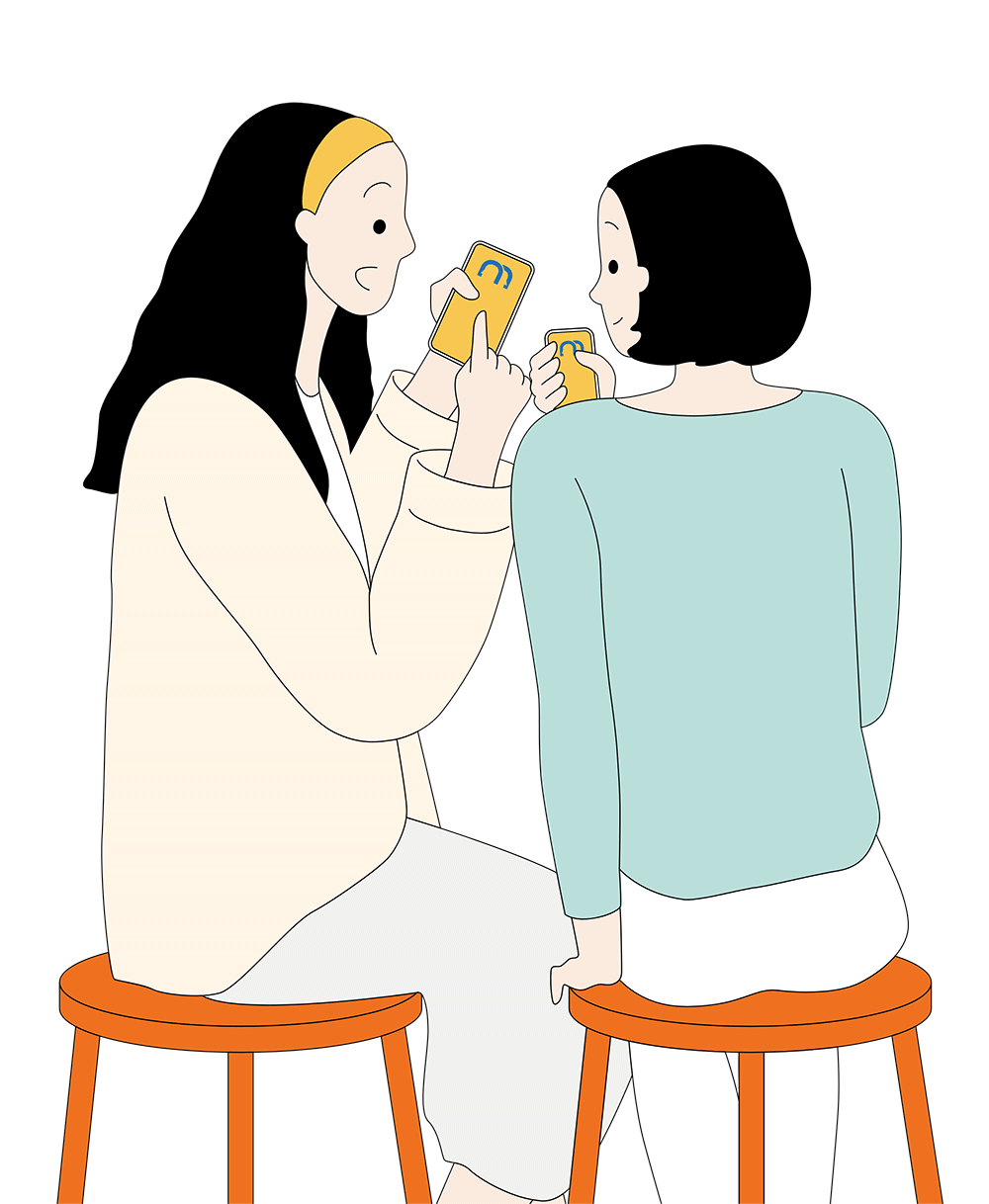
Get 2-week FREE
Chinese Classes
Original Price: ¥600
Get 2 Weeks of FREE Chinese Classes
Original Price: ¥600

